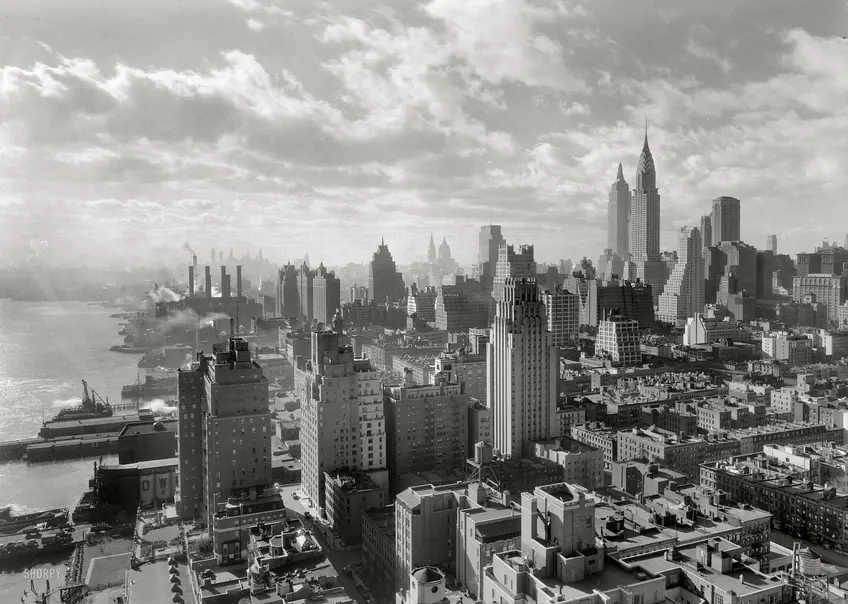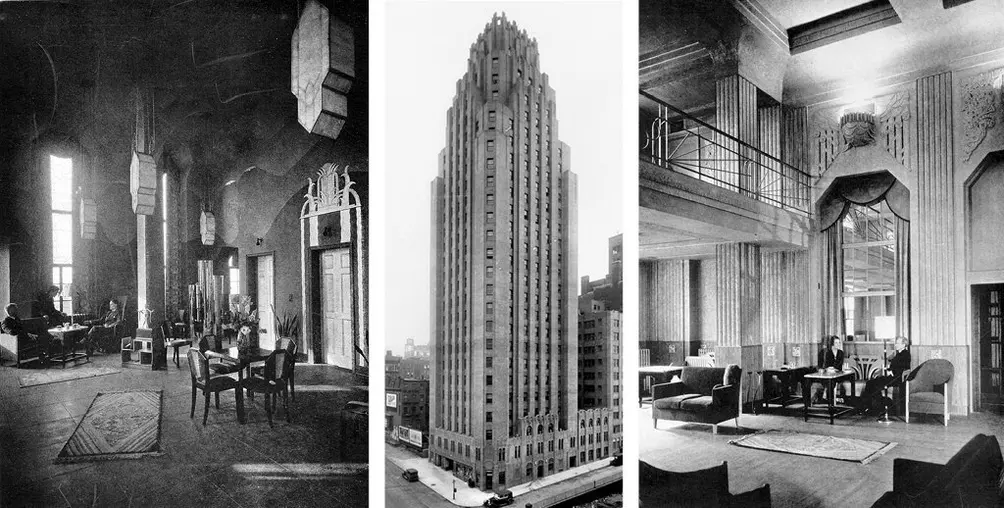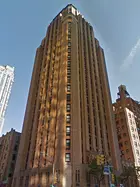 1931 photo with Beekman Tower centered by photographer Samuel H. Gottscho via Shorpy
1931 photo with Beekman Tower centered by photographer Samuel H. Gottscho via Shorpy
In the coming weeks, a new cocktail lounge will open atop the landmarked Beekman Tower at 3 Mitchell Place in East Midtown. The 28-story-tall, celebration of verticality and the Art Deco style was originally known as the Panhellenic Tower and later the Beekman Tower Hotel. Few specific details have been released on the venue but according to their Instagram account it was announced that Chef Stephen Putnam will be leading the culinary team and the name Ophelia is derived from Shakespeare’s Hamlet to symbolize her “sense of true passion and history.”
The aerie will be painted in rich blues “reminiscent of the glamour of the 1920's.” says the project team. “The Beekman Tower used to be a place where Frank Sinatra would hang out after shows and where he would give small performances. We're happy to be bringing old-world glamour back to the Beekman with our concept Ophelia.” While the views from the lounge will not be as sweeping as they were in the 30s, the panorama does include gracious views of the Midtown skyline, the East River, and Queens.
In this article:
 Illustrations of Ophelia via @opheliany Instagram
Illustrations of Ophelia via @opheliany Instagram
Erected in 1928, the building originally had 380 rooms and served as a residence and clubhouse for women belonging to Greek-letter college sororities. Its builder was Emily Eaton Hepburn who was the president and majority stockholder of the Panhellenic Association and wife of Barton Hepburn, who would become president and chairman of the Chase National Bank. The tower provided affordable housing for 400 young, college-educated women who were entering the New York City workforce in record numbers in the 1920s
When the project was conceived, its Beekman Place neighborhood was just starting to become the tony residential enclaves we know them as today. The Landmarks Preservation designation report says, “There were slums and slaughterhouses to the south and west, transportation was bad, and neighborhood shopping was non-existent. However, Mitchell Place intersected with the southern end of Beekman Place which was beginning to be developed following the construction of two large apartment buildings, Beekman Terrace (1924) and Beekman Mansion (1926), on East 51st Street.”
 via the NYTimes (Credit: redit Left and right, Avery Library; center, Museum of The City of New York)
via the NYTimes (Credit: redit Left and right, Avery Library; center, Museum of The City of New York)
 From L to R: Empire State Building, Beekman Hotel Tower, and River House (East River shoreline by Gottscho-Schleisner via Shorpy)
From L to R: Empire State Building, Beekman Hotel Tower, and River House (East River shoreline by Gottscho-Schleisner via Shorpy)
Hepburn commissioned architect John Mead Howells to design the building. His previous works include St. Paul’s Chapel at Columbia University and the Chicago Tribune Building which he designed in collaboration with Raymond Hood. Fiercely Art Deco, the Panhellenic Tower was wrapped in rust-colored brick complemented with monolithic chamfered corners, crenelated decorations, and strong vertical lines. Per the designation report,” Howell turned the need for light courts on the sides of the Panhellenic into a virtue, creating a powerfully modeled design that made the building seem ‘more a solid mass than a hollow container.’ This impression of solid mass is enhanced by the bold vertical striping of the deeply recessed window and spandrel bays between wide piers
 Top-floor lounge prior to renovation (via Douglas Elliman)
Top-floor lounge prior to renovation (via Douglas Elliman)
The onset of the Great Recession forced the organization to take men as well, and its name was changed to the Beekman Tower in 1934.and to supplement its income, cocktail lounges were installed at the ground floor restaurant and within the top floor solarium which was renamed the Tower Room. Renowned for its spectacular views, the book New York 1930, Architecture and Urbanism Between the Two World Wars says “The lounge space has dark tones and sinuous patterns on the walls helped obscure the awkwardness of the room’s shape, while pendant light fixtures, waving fronds of metal foliage, applied around the central elevator door, tall lancet windows, and French-influenced furniture gave the room a welcome note of romantic mystery,”
The Beekman Tower was one of only five hotels in New York City to survive bankruptcy during both the Great Depression and World War II. The building became fully air-conditioned in 1960 and in 1964 the building was sold to Benjamin J. Denihan and Arthur W. Bresciani Sr. who converted it to an apartment hotel with new bathrooms and kitchenettes.
In 2013, Silverstein Properties, Fisher Brothers, and Capstone Equities acquired the property for $82 million and converted it to a 181-unit, full-service rental. Availabilities show one-bedrooms are priced from $3,589/month. Rent includes all utilities and embedded in the price is one month free on 18-month lease. Amenities include a 24-hour attended lobby, concierge services, laundry room, business center and lounge and a fitness center — and soon, a romantic rooftop lounge appropriately named Ophelia.
In 2013, Silverstein Properties, Fisher Brothers, and Capstone Equities acquired the property for $82 million and converted it to a 181-unit, full-service rental. Availabilities show one-bedrooms are priced from $3,589/month. Rent includes all utilities and embedded in the price is one month free on 18-month lease. Amenities include a 24-hour attended lobby, concierge services, laundry room, business center and lounge and a fitness center — and soon, a romantic rooftop lounge appropriately named Ophelia.


 6sqft delivers the latest on real estate, architecture, and design, straight from New York City.
6sqft delivers the latest on real estate, architecture, and design, straight from New York City.
